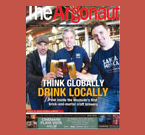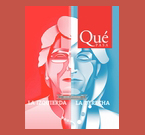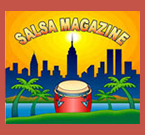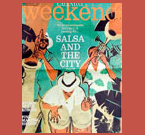REVIEWS
Charanga on the water
Posted March 11, 2015 by The Argonaut in This Week
Cuban jazz ensemble lends Fisherman’s Village a different rhythm
By Michael Aushenker
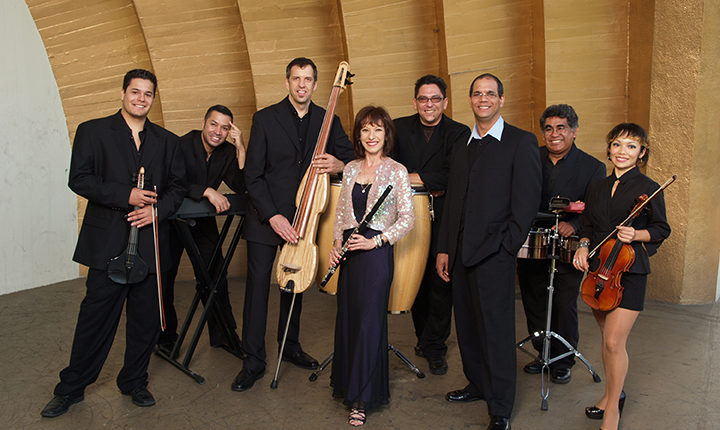
Orquesta Charangoa, led by Fay Roberts (center), is headed back to Marina del Rey.
By way of Cuba, a Jewish Valley girl of Eastern-European heritage who was raised on radio pop and bluegrass became an ambassador of the island’s musical soul. And now flutist and saxophonist Fay Roberts is on a roll.
The devotee of Cuban-born charanga music and her band Orquesta Charangoa has performed free outdoor concerts at Fisherman’s Village in Marina del Rey every three months for the past two years.
They return Saturday, this time in-between a new Sunday-night residency at the retro-swank Culver Hotel in Culver City.
Depending on the setting, Orquesta Charangoa counts either six or nine members, including James Zavaleta (lead vocals), Fermin Sifontes (piano, vocals), Alfred “El Nino” Ortiz (timbales, vocals), Rayen Fernandez (congas, vocals), Jonathan Pintoff (bass) and Harry Scorzo, Pablo Isaac Mendez and Tylana Regna (violins).
Classically trained with a B.A. in music from UC Santa Barbara, Roberts moonlights part time as music director at the Braille Institute, where she manages an intensive jazz studies program. She is also a card-carrying member of the National Flute Association and a featured Yamaha artist.
If you are wondering how she found her way to Cuban jazz, the story began in the 1990s when Roberts caught Artie Webb at the King King club. A deepening interest in performing charanga then led her to visit Cuba twice in 1996 to study with one of her heroes, the legendary Richard Egues of Orquesta Aragon. Egues was a master of the Cuban flute style who composed Cuba’s most popular cha cha cha, “El Bodeguero.” On her second trip, Roberts stayed at the bandleader’s house, studying with the 73-year-old virtuoso.
“He gave me several music charts and told me to go back to L.A., start a band and keep his music alive,” Roberts says.
She took her mentor seriously, returning to Los Angeles and forming Orquesta Charangoa in 1997. The band’s first album, 2005’s eponymous “Fay Roberts Y Su Orquesta Charangoa” featured a Latinized version of the Beatles gem “Blackbird” plus several Egues originals: “Por Eso Hay Cosas,” “E Ay Marisela” and “Son Yayabero.” Egues died in 2006 at 83.
A second album, 2011’s “Lo Que Quiero Es Charangoa,” featured originals composed by band members and another interesting cover: Lady Gaga’s “Just Dance.”
Charangoa are now working on a new album. When they compose, “the whole group is able to improvise together,” Roberts said.
Asked which songs are particularly complicated to perform on flute, “All of it,” she said. “It’s all into the third and into the fourth register. It’s a lot of high notes.”
But the corazon of why she prefers Latin jazz is because it is more “rhythm-centric” than its more “harmonic” American counterpart.
Paint Roberts pleased as punch (make that sangria!) to return to familiar turf at Fisherman’s Village.
“Our fans really like it there because it’s a beautiful place,” Roberts said, gushing about playing the marina. “It’s free to go, it’s outside, and it’s a gorgeous setting. People come specifically to see us and dance.”
Orquesta Charangoa performs at 1 p.m. Saturday at Fisherman’s Village (13755 Fiji Way, Marina del Rey) and at 8 p.m. Sundays through May 31 at the Culver Hotel (9400 Culver Blvd., Culver City). Visit charangoa.com for more information.
michael@argonautnews.com
Salsa swings as the main course
Article by By Laura Ferreiro – August 26, 2012
To the casual observer, Burbank may not look like a hotbed of salsa and swing dancing. But anyone looking a little more closely this summer would have discovered crowds filling the sidewalks of downtown Burbank every Thursday night, stepping out to the smooth stylings of renowned salsa, rock and swing ensembles.
Concluding next week with a performance by Louis Cruz Beltran and his orchestra, Burbank’s Business Improvement District has been organizing the popular “Come Out and Dance Series” for nearly a decade. Events are held along the AMC Theatre walkway at San Fernando Boulevard and Palm Avenue, and are free and open to the public. The series draws an eclectic crowd, including local families, young and seasoned music lovers and dance aficionados, as well as those who fortuitously stumble upon a free show while shopping in the popular downtown district.
Lively bands including rock ‘n’ roll revivalists Captain Cardiac and the Coronaries, L.A. Cuban salsa purveyors Orquesta Charangoa and renowned salsa orchestra La Sirena y Orquesta Mar De Ashe have performed at the weekly, all-ages concerts this summer, which bring out an average of 2,000 people every Thursday night.
“I really enjoy playing events where the whole family can attend,” said La Sirena, leader of Orquesta Mar De Ashe. “That’s the beauty of events like this. You don’t have to pay for a babysitter — bring everybody and bring your kids and let them be exposed to culture and let them learn to dance. That’s one of the things that attracted me to salsa in the very beginning. It attracts people of all ethnicities and socio-economic levels, and of all ages. And you’re never too young to learn to dance salsa!”
The city of Burbank also organizes other events throughout the year, such as family celebrations for several holidays, the Burbank Arts Festival in November, car shows, and the Downtown Burbank Farmer’s Market every Saturday morning.
“The main goal of the Business Improvement District is to benefit business and property owners,” said Marissa Minor, the district’s operations coordinator. “We hope to strengthen the Burbank community and bring in lots of shops and restaurants. It’s a fun area where people can come together.”
As part of the dance series, local instructors offer free dance lessons, usually starting at 6 p.m., giving attendees an hour to practice their moves before the bands go on at 7 p.m. Here you’ll find dance students of all ages, shapes and sizes honing their turns and dips, and encouraging new attendees to join in on the fun.
“It was great to see the very high participation in the dance class — they had really good energy,” said flutist Fay Roberts who leads salsa band Orquesta Charangoa. “It’s not pretentious or snobby. The dancers are really having fun with the band and they’re really into it.”
Minor pointed out that in addition to the concerts and dance lessons, several Burbank businesses are finding creative ways to bring people together while having a good time and giving back to the community. “Flappers Comedy Club does comedy shows to raise money for various nonprofit organizations, and My Big Fat Greek Restaurant recently held a fundraiser for the Burbank Temporary Aid Center,” she said.
Now that the summer series is winding down, Burbank city organizers are already planning ahead for next year.
“We’ll definitely have more events next summer,” Minor said. “We might change it up a bit, but it will always be free and a great opportunity to come out and meet the neighbors.”
La Sirena said it’s inspiring to see Burbank putting on these types of family-friendly events.
“You see people from age 8 to 80 come out,” she said. “In this country, ages have become very separated, and that’s a sad thing. Anything like this series that can bring them together is a great thing. I myself will dance with anybody — I don’t care how young or how old, as long as they don’t stand on my feet!”
Zuazola’s Blog
¡Quien se lo cree!
Article by J. Zuazola, junio 2012
Charanga en el Parque, quien se lo cree! por Juan Zuazola
Era domingo a la tarde, un 27 de junio, fuimos invitados por unos amigos a pasar un rato en el parque de La Cañada, California, a oir música cubana, cosa que nos extrañó, pero bueno, claro que no dijimos que no. Es como decirte: “te invito a comer un helado de mamey en el desierto de Arizona”, ¡quien se cree esa! Llegamos al parque, era al atardecer, todavía hacía calor, pero ya mermaba. Una suave brisa barría la explanada de una alfombra de hierba de un verde brillante en forma de auditorio natural del parque de La Cañada. Habíamos comprado algo para comer y beber que llevamos en unas cestas de picnic, estiramos unas mantas y nos echamos en la hierba. Habíamos traido los cubiletes por si nos aburríamos. Abajo, en el punto central más visible del parque, una “glorieta”, algo, no muy común por estos lares, que nos trajo de pronto “un flashback” de tiempos ha, algo coloniales, aunque la glorieta era de estilo moderno. En la semipenumbra de la glorieta se veían unos músicos afinando sus instrumentos. Eran unos 7 ó 9, no se, no le prestamos mucha atención, comenzamos a beber, comer y disfrutar de la grata compañía de los amigos, siempre haciendo chistes. El parque estaba lleno de grupitos de familias como nosotros. Había de todas las edades, de la primera a la tercera, unos menos viejos en cochecitos y pañales y otros menos jóvenes en sillas de rueda y bastón. Saludamos a otros amigos más que hacía tiempo que no nos veíamos y que nos vieron llegar. Cuando de pronto, en el silencio de la inmensidad del parque, rompe la orquesta a tocar. ¡Era tremendo cha, cha, cha! Sí, chá, chá, chá, con acento bien grande en la “á.” No lo podíamos creer, junio del 2004, en La Cañada, al pie de las montañas que rodean Los Ángeles, “tremendo chá, chá, chá al aire libre,” sin que ninguna pared atrapase, ni rebotase, ni nos robase las notas musicales que salían de esos instrumentos, eran todas para nosotros. Que experiencia. Y detrás de ese chá, chá, chá; otro y otro más. “La Engañadora”, “El Bodeguero”, “Cachita”, “Me voy pa’ Morón”,….así fueron viniendo. No pudimos más, nos levantamos de las colchas y nos fuimos a bailar. ¡La sangre ñama, los pies se nos alborotan! Sin siquiera cerrar los ojos, era como oír la victrola del bar de Mendoza en la Carretera Central hacia Perico, como estar bailando en el Liceo de Perico, como oír la victrola del bar de Bencito en Güines, como estar bailando en el Casino Español o en el Brage Yatch Club de Güines, como estar en las charangas de Bejucal, echando un pie con la Aragón en los jardines de la Polar o la Tropical en una tarde de verano, con Enrique Jorrín, con la Orquesta América de Ninón Mondejar, con la América del 55, con la Sensación, la Sublime, con la flauta de Richard Egües o de Fajardo y sus Estrellas, era oír la orquesta tocando en la glorieta del parque de Matanzas, era estar esperando la transferencia en la esquina de Tejas comiéndonos una frita y oyendo la victrola de un bar cercano, era como estar bañándose en la piscina olímpica del Casino Deportivo con un “mojito” en la mano y oyendo la música del salón, como estar en las fiestas de Nuestra Señora de Regla o en la Tutelar de Guanabacoa, o en tantos rincones de nuestra lejana tierra cubana que tantos buenos recuerdos nos traen cuando pensamos en ellos. Eran los inolvidables años cincuentas. Ahora diríamos, como dicen aquí, eran “the fabulous fifties.” Lo de hoy no era un DJ tocando discos viejos “digitalizados”, era de verdad y “en vivo y en directo”, aprendimos que era la “Orquesta Charangoa” que nos deleitaba con un vasto repertorio de legítima música cubana: chá, chá, chá, guarachas, conga, merecumbé, etc. desde esa glorieta del parque de La Cañada. Que ritmo, que voces, que flauta, que piano, que violines. Era, como dicen aquí, “the real thing.” Era; ¡Que cosa má’ grande ‘e la vida!…, como diría Tres Patines, que en paz descanse. La “Orquesta Charangoa” se formó aquí en Los Ángeles y están deleitando a los públicos de California desde 1996.
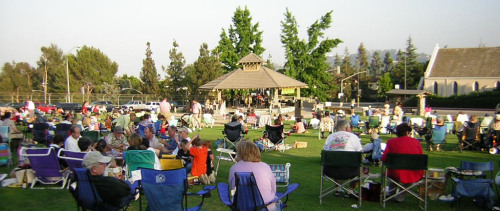
NOTA: Ésto es parte de un artículo que fue publicado en el periódico “Que Pasa” de Roberto Fernández en junio de 2004
FAY ROBERTS Y SU ORQUESTA CHARANGOA
Lo Que Quiero Es Charangoa
Reviewed by DJ Walter “B” Nice for Salsa Magazine
 Wow! I’m really pulling out the goodies today. Here is another great CD by Fay Roberts Y Su Orquesta Charangoa, entitled Lo Que Quiero Es Charangoa. Fay Roberts is an understudy of legendary Cuban flutist and composer “El Maestro Richard Egues” of Orquesta Aragon, and with her latest disc she attempts to carry on his legacy with an album full of hardcore Charanga tracks that are sure to pack the dance floor. The project even includes a cha cha-infused track with English vocals provided by American pop star Lady Gaga, called “Just Dance.” All you Charangueros should rejoice because this CD is the BOMB and a must add to your salsa collection. Esa Va!!!!
Wow! I’m really pulling out the goodies today. Here is another great CD by Fay Roberts Y Su Orquesta Charangoa, entitled Lo Que Quiero Es Charangoa. Fay Roberts is an understudy of legendary Cuban flutist and composer “El Maestro Richard Egues” of Orquesta Aragon, and with her latest disc she attempts to carry on his legacy with an album full of hardcore Charanga tracks that are sure to pack the dance floor. The project even includes a cha cha-infused track with English vocals provided by American pop star Lady Gaga, called “Just Dance.” All you Charangueros should rejoice because this CD is the BOMB and a must add to your salsa collection. Esa Va!!!!
Be sure to preview one of the standout tracks from the album, Preparen Candela.
CD Notes
Song titles include:
- Que Viva La Charanga
- Lo Que Quiero es Charangoa
- Preparen Candela
- Son Montueando
- Vengo Diferente
- Cuidado Qu Se Pega
- No Tiene Rival
- Oye Como Va
- Sombrero de Yarey
- Danzonette
- Just Dance
Musicans include:
Fay “Fela” Roberts, Flute (Yamaha Artist), Arrangements, Leader
Alfred Oritz, Congas, Vocals
Fermin Sifontes, Piano, Vocals
Jonathan Pintoff, Bass
George Ortiz, Timbales
Tony Alba, Guiro
Pablo Mendez, Sr., Pablo Mendez, Jr., Violins
Special Guest Vocalists, Adonis Puents, Johnny Cresp, Gonzalo Chomat (Timba Artist) and James Zavaleta
Special Guest Composers:
Johnny Crespo
Matt Amper
Fermin Sifontes
AUGUST 2011 ISSUE
LOS ANGELES HIT PARADE
(Guido Herrera KXLU 88.9 FM)
1. Lo Que Quiero Es Charangoa/Fay Roberts Y Charangoa
2. Palo Mayombe/Mongorama
3. Quirino Con Su Tres/Jane Bunnett And Hilario Duran
4. Pure Imagination/Dave Valentin
5. Monterey/Steve Kroon
6. Festejo Lando/Kiki Sanchez
7. Boco Boco/Lucky 7
8. El Esqueleto Rumbero/John Santos Sextet
9. Mecanica/Tiempo Libre
10. Los Gaiteros/Steve Khan
11. Suena El Timbal/Tony Fuentes Y La Orquesta Milleni K
12. Isora Club/Cachao (LIVE)
13. Madre/Frankie Morales
14. Resumen De Los 90/Alexander Abreu
15. La Voz Del Pueblo/Choco Orta
16. Buey Viejo/Gregor Huebner
17. Rumba En La Lluvia/Henry Fiol
18. Ella No Esta En Na/Jose Alberto “El Canario”
19. Mambo Inn/Arturo Sandoval and The WDR Band
20. Conga Melody/Luis Conte
LO QUE QUIERO ES CHARANGOA
Fay Roberts y su Orquesta Charangoa (Charangoa)
Reviewed by/Reseña por: Omar Walker Translated by/Traducido por: Jacira Castro
English
On their second release, Fay and Charangoa have found a swinging groove.
With more aggressive arrangements they sure can throw down with any salsa/timba band. Take the classic “No tiene rival” from Las Tres Flautas (Pacheco, Pupi and Fajardo) where singer Gonzalo Chomat and conguero Alfred Ortiz are coming at you with both barrels loaded. Tito Puente’s “Oye como va” gets a nice rework with some terrific violin solos.
Fay shows off her flute chops on Richard Egües’, “Cuidado que se pega”. And while she doesn’t have the mastery of her mentor (who really does?) you can hear his influence the way her notes flow with such fluidity, unlike some of today’s players.
While many bands have added other instruments to the charanga format (horn sections, synthesizers, etc.), Fay and Charangoa have opted for a straight Charanga unit, with no gimmicks. Now, if we can just get them some original material and avoid them falling into the box of cover bands.
Español
En su segundo álbum, Fay and Charangoa han encontrado su onda con swing. Con arreglos más agresivos, ellos pueden competir con cualquier conjunto de salsa o timba. Toma el tema clásico “No tiene rival” de las tres flautas (Pacheco, Pupi y Fajardo) donde el cantante, Gonzalo Chomat y el conguero, Alfredo Ortiz están disparando con todo lo que tienen. El tema de Tito Puente, “Oye como va”, es reinterpretado con unos sólos de violín fenomenales.
Fay se destaca con la flauta en el tema de Richard Egües, “Cuidado que se pega”. Aunque no tenga la maestría de su mentor (¿quién sí lo tiene?), puedes escuchar su influencia en la manera que las notas fluyen con tanta fluidez, distinto de muchos artistas hoy en día.
Algunas bandas han añadido otros instrumentos al formato de la charanga (bronces, sintetizadores, etc.), Fay and Charangoa han optado por una charanga tradicional, sin juegos. Ahora, si podrían lograr incluir materia original para evitar que caigan a la caja de conjuntos que sólo tocan los “covers”.
Songs / Canciones
1. Que viva la charanga
2. Lo que quiero es charangoa
3. Preparen candela
4. Son montueando
5. Vengo diferente
6.Cuidado que se pega
7. No tiene rival
8. Oye como va
9. Sombrero de Yarey
10. Danzonette
11. Just Dance
Musicians / Músicos
Fay Roberts: Flute
Alfred Ortiz: Congas, Vocals
Fermin Sifontes: Piano, Vocals
Jonathan Pintoff: Bass
George Ortiz: Timbales
Tony Alba: Güiro
Pablo Méndez, Sr., Pablo Méndez, Jr.: Violins
Adonis Puentes, Johnny Crespo, Gonzalo Chomat: Vocals
James Zavaleta: Vocals
Fay Roberts Y Su Orquesta Charangoa
Lo Que Quiero Es Charangoa CD (Charangoa 2011)
Released 2011
Editor’s Pick: Best of 2011 Award Winner
Link to this Article

Yum… One of the hardest-driving charanga orchestras playing today, flautist Fay Roberts and her Orquesta Charangoa have just released a smoking album that will make your toes curl. Roberts studied under the legendary Richard Egües, of Cuba’s Aragón fame, and the flute master helped to initiate what might be the purest and most essential charanga organization in the US. At times a churning locomotive, at times sublime, Lo Que Quiero Es Charangoa has that rare transformative power to create a state of sensory euphoria. This, folks, is a Must Have. Very Highly Recommended.
The story starts when Fay Roberts traveled to Cuba to study flute with the legendary Richard Egues, of Orquesta Aragon fame. Richard, an innovative virtuoso of the Cuban flute style is also the composer of one of Cuba’s most popular cha cha cha’s, El Bodeguero. Richard sent Fay home with enough music and inspiration to start a new Cuban charanga orquesta. Though consistent correspondence Richard guided the creation on L.A/s most authentic Cuban dance group Orchesta Charangoa.
(BP, 2011-06-24)
Song titles include:
Que Viva La Charanga
Lo Que Quiero es Charangoa
Preparen Candela
Son Montueando
Vengo Diferente
Cuidado Que Se Pega
No Tiene Rival
Oye Como Va
Sombrero de Yarey
Danzonette
Just Dance
Musicians include:
Fay “Fela” Roberts: Flute (Yamaha Artist), Arrangements, Leader
Alfred Ortiz: Congas, Vocals
Fermin Sifontes: Piano, Vocals
Jonathan Pintoff: Bass
George Ortiz: Timbales
Tony Alba: Guiro
Pablo Mendez, Sr., Pablo Mendez, Jr.: Violins
Adonis Puentes, Johnny Crespo, Gonzalo Chomat (Timba Artist), and James Zavaleta: Vocals
FAY ROBERTS’ ORQUESTA CHARANGOA
by Rudy Mangual

Flutist/bandleader Fay Roberts established Orquesta Charangoa in 1997 in Los Angeles, inspired by the teachings of the legendary Cuban flutist/composer Richard Egües. Roberts traveled to Cuba to study with Egües and returned home with enough music and inspiration to form an authentic Cuban charanga band.
This classically trained flutist follows the traditional style of early popular Cuban dance orchestras, a genre called charanga, which was developed from the contradanza criolla string ensembles of Cuban elite society. The instrumentation of a charanga ensemble consists of a lead flute, violins, and a rhythm section of congas, timbal, güiro, piano and bass, plus vocal harmonies.
Roberts, who earned a B.A. in Music from the University of California at Santa Barbara (UCSB), is a Yamaha Instruments endorsee, playing the 800 series wood flute (grenadilla flute).
Since 1997, Charangoa has performed in many of Los Angeles’ top music venues including the Dorothy Chandler Pavilion, the Hollywood Palladium, The Palace, The Conga Room, and The Granada, in addition to its regular gigs at the popular El Floridita Restaurant in Hollywood.
A performance by Fay Roberts and Orquesta Charangoa is a musical odyssey of chachachás, mambos, boleros, guajiras, and sones montunos. Her self-produced debut CD, Fay Roberts y Su Orquesta Charangoa (2005), showcases the virtuosity of this wonderful bandleader and her talented group of musicians.
Salsa holds sway in L.A.
COVER STORY
Dozens of orchestras, playing myriad variations, help the style thrive here.
September 13, 2007 | Ernesto Lechner | Special to The Times
One of the first things that you learn about salsa dancing is that on the count of four you are supposed to stop moving your feet and take a short pause. This syncopated break pushes you to shake the hips, and it can be shortened or stretched according to the mood of the song. The pause is the key to salsa — the very essence of its mystique. On a good night, the pause can make you feel that the entire world has stopped turning.
On a weeknight a few months ago at Mama Juana’s, the cozy Studio City nightclub, I found myself pondering the elusive nature of that very salsa step. During the last 10 years, I had developed a torrid love affair with tropical music, become a Latin music critic and amassed thousands of albums. But my dancing skills were still nonexistent — owing to my innate clumsiness, not to mention a morbid Buenos Aires childhood spent listening to my brother’s Pink Floyd records.
After a number of false starts, I had found a teacher with the titanic patience to tutor a student such as myself. Ken Baldwin, a soft-spoken Japanese American, laid out simple patterns with precise instructions, focusing on the power of salsa to inspire your soul, and less on the showy pirouettes most students expect to learn.
But in Los Angeles, it’s often what you learn to appreciate after the dance lessons that’s just as magical: a performance by a superlative salsa band. The lively variations on the feverish combination of Afro Caribbean music’s percolating percussion and funky brass riffs run like threads through the fabric of a city where salsa thrives thanks to dozens of orchestras that, against all odds, continue to ply their trade.
“I know it’s kind of incredible to say this, but Los Angeles has more of a salsa scene than New York these days,” says Oscar Hernández, leader of the Spanish Harlem Orchestra, the most successful and respected salsa combo in the U.S. “In New York, the quality of the music may be a bit higher, but the generation that supported salsa 30 years ago has moved on. In L.A., Latinos from all walks and nationalities are getting into this music, which explains why the scene is bigger here.”
The variety of available soundscapes is actually breathtaking.
Consider:
* After a number of years following the aggressive Cuban style known as timba, Son Mayor has recently returned to the classic sound of ’70s New York, when artists such as Willie Colón and Ray Barretto took the movement to its creative apex by combining the raw danceability of Afro Cuban styles with big band jazz and gritty R&B influences. Son Mayor’s version of the Roberto Roena classic “Con Los Pobres Estoy” is, in the words of bandleader Erasmo “Eddie” Ortiz, “brutally violent.”
* Led by conservatory-trained trombonist Denis Jirón, Rumbankete anchors its epic sound on majestic layers of trombones — following the aesthetic of pioneering orchestras such as Eddie Palmieri’s La Perfecta and Manny Oquendo’s Conjunto Libre. Rumbankete’s cover of the Libre standard “Alabanciosa” is a sophisticated delight.
* Favoring a lighter, more elegant sound, Charangoa is the modern version of a typical Cuban charanga — a tropical ensemble that combines joyous violins with acrobatic flute solos. The ultimate charanga band was Cuba’s Orquesta Aragón. Charangoa follows its sunny, ever-smiling parameters.
* The chocolate-voiced Ricardo Lemvo, a native of Congo, has fused the rootsy vibe of classic Cuba with the spiraling guitars of Congolese rumba. The result is dance music at its most transcendental. Lemvo is the only local bandleader who regularly releases high-quality CDs of original material.
* Led by Costa Rican trumpet player Oswaldo Bernard, Opa Opa is noted for the voracious appetite with which it embraces all shades of the tropical palette: The band performs Dominican merengue, Cuban boleros, Puerto Rican bomba and Colombian cumbia with equal panache.
* Sponsored by Albert Torres, the dancer and promoter who is almost single-handedly responsible for the creation of the local salsa scene, former auto mechanic Johnny Polanco has developed into a talented multi-instrumentalist and leader of a well-oiled ensemble that performs virtually every day of the week. Their cover of Spanish Harlem Orchestra’s 2004 scorcher “Un Gran Día en el Barrio” is almost as good as the original.
The list goes on: Yari Moré. Chino Espinoza y los Dueños del Son. Orquesta la Palabra. The Echo Park Project. Susie Hansen. Octavio Figueroa y la Combinación. Luis Centeno y su Orquesta Melaza. And many more.
A big influence
Hernández, a quintessential New Yorker, rose as one of the most talented pianists and arrangers in the field during the ’80s, when he recorded seminal albums with Barretto and Rubén Blades.
Last year, Hernández got married and moved to L.A., where he spends most of the time when he is not touring with the Spanish Harlem Orchestra. During this year’s edition of Albert Torres’ Salsa Congress, he was invited onstage by venerable Puerto Rican combo La Sonora Ponceña. The prospect of a local orchestra led by him could revolutionize the entire scene.
“I’ve thought about forming a local band that I could play with whenever I am in town,” he says. “The problem is that many of the salsa musicians in L.A. are underpaid and disrespected. They are in a situation where they play four sets a night and get $80 for their effort. I refuse to work on that level. With the Spanish Harlem Orchestra, the musicians are well paid. I’ve made it a point to emphasize quality over quantity.”
Tropical bands have been criminally underpaid from the very inception of the genre. But the musicians carry on, undeterred. The cliché, in this case, applies: It’s all about the music.
“The local bands, we’re all on the same boat,” Opa Opa’s Bernard says with a laugh. “None of us is rich, but we all take turns performing in the few available venues. You don’t play this music for the money. You do it for love.”
Says Rumbankete’s Jirón, who has performed with Kanye West, Sting, Queen Latifah and the L.A. Philharmonic: “Having my own salsa band plays a different role in my life. It’s like therapy.”
Musicians are not the only ones who find therapeutic elements in this music. “I can have the worst day ever, but the moment I get on the dance floor, it all goes away,” says Lisa Bellamore, a publicist who learned salsa dancing when she lived in Boston. “The environment seems incredibly soulful to me. It’s a space where it’s OK to let go. When you hear those bass lines — that beat that drives everything in salsa — you have no choice but surrender to it.”
According to Son Mayor’s Ortiz, it is the support of the dancers that keeps the local scene moving.
“We owe our very existence to them,” he offers. “And they’re not only Latinos. Many of our fans are Anglos who got the salsa bug, and when we play at Alhambra’s Granada, there are a lot of Asians on the floor. I think it’s great that all these different ethnic groups are having so much fun with our music.”
A promotion
As the months went by, my lessons at Mama Juana’s began to pay off. The circle was beginning to close: My dancing was somewhat adequate. I would not embarrass my wife and daughter at family parties anymore.
Most important, my love for the music was stronger than ever. Performances by the likes of Son Mayor and Polanco reinforced my notion that salsa is the quintessential expression of the Latin American experience. It has humor and tragedy, eros and Thanatos, academic virtuosity and streetwise sensibility. At its best, salsa rocks harder than rock.
On a recent return to Mama Juana’s, I asked Baldwin about that special moment in the basic step — the hesitation on the four count.
“The pause is like that moment when you throw a ball in the air — it’s not going up anymore, but not coming down either,” he says. “For a second, the ball is floating, transferring its energy from rising to falling. The energy is still there, but it’s suspended in the air, weightless.”
Suddenly, he looked surprisingly serious.
“Don’t come back here on Wednesdays,” he said sternly. “I don’t want to see you in the beginner’s class anymore.”
CHARANGOA
Interview By Wally Escobar
Photos by Amy Flores

In these times when Salsa, Cuban Son and different types of rhythms are continuing to evolve, the very traditional Cuban Charanga is well kept by very few orchestras. Charanga is a specific style of instrumentation consisting of contrabass, timbales, and guiro, strings (from two to four violins, or any number of violns with a cello), and one flute, (the piano and con- gas were integrated in the 40’s). Since 1997 Fay Robert’s Charangoa based out of Los Angeles, has been keeping the flame with their traditional Charanga. Having studied with the legendary Richard Egues (Orquesta Aragon), Fay was inspired to form her own traditional Charanga orchestra. Under the guidance and help of maestro Egues, Fav was able to begin her journey. Going on 7 years, Charangoa has managed to appear in some of L.A’s top venus, KTTV’s ‘Good day L.A. and many different festivals throughout Los Angeles. I was able to catch up with Fav Roberts and discuss Charangoa’s success and future plans.
SABOR: Where does Charangoa perform?
FAY: Every Friday night at El Floridita Restaurant, Mama Juana’s and the Havana House. In July we will be playing at the Manhattan Beach Concert Series.
SABOR: What does Charangoa bring that other bands don’t bring?
FAY: Ihe real Charanga sound, the Cubans sound, the regular Charanga sound with the strings and the flutes in a way so you can hear the strings and flutes. I think that flute and drums are like two ancient instruments that have always been connected, flute and drums are a magical combination.
SABOR: Since timbalcs and strings are so significant in charanga, do you try to bring that out more?
FAY: They are the groove thing, and when you see us play there’s something hypnotic and beautiful of just watching them play.
SABOR: You are basically the only traditional Charanga orchestra in L.A. right
FAY: We are the only straight up Charanga band that doesn’t have other instruments that are not part of the Charanga style.
SABOR: How has it been to be connected to the legendary Richard Egues?
FAY: Oh! It’s a complete honor and for anyone who knows him, he’s a delight. He’s wonderful, joyful, alive, vibrant, and a very musical person to work with and study with. Both times I was in Cuba I took lessons everyday. I didn’t sightsee, I didn’t party (laughs).
SABOR: Maintaining a band can be so difficult, what have you done to maintain your band after 7 years?
FAY: Its been really great for the past year because I’ve had a real steady crew. I have the same people 95% of time which helps. Also tolerance, being conipletely willing to listen to people, not having to be right about every single thing. Learning more about direct ing the band, make sure that thes’ feel how much I appreciate them. I think I run this band differently than other band leaders do, I always focus on the musicians knowing how much their appreciated. We keep changing the music around, we love the music and we just really wanna play.
SABOR: Where does Fay Roberts want to take Charangoa in the future?
FAY: A recording, we’re working on a new demo right now and that’s the next step. I’d like to record original material that Richard Egues gave me. As far as my research shows, these songs have not been record ed in Cuba or in the States.
SABOR: Is there anyone in particular that has been key to the success of Charangoa from the beginning to now that you would like to mention?
FAY: I would like to thank the Ortiz brothers for all their help. All the musicians from Charangoa right now, because I cant do it alone and the make it happen. Armando Castro Sr. and Armando Castro Jr, for their endless support.
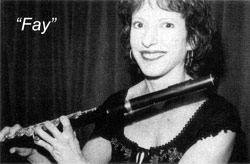
Besides being the backbone of Charangoa, Fay can be seen directing a music program at the Braille Institute in Los Angeles.
Fay Roberts is a Yamaha artist and you can find out more about charangoa by visiting www.charangoa.com.
Latin Beat Magazine
Latin Jazz, Afro-Caribbean, Salsa and More …
March 1997 Volume 7, Number 2
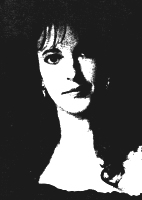
NEW BLOOD
She is young, beautiful, was inspired by flutist Artie Webb to become an ambassador of the Cuban Charanga, studied with the renowned flutist Richard Eques of Cuba, and holds a Bachelor’s degree in music from the University of California. Her love affair with Latin music began in the eighties after hearing a local salsa orchestra at Santa Barbara. She added the saxophone and clarinet to her repertoire and began performing with a few Los Angeles groups. As a part time musical director for the Braille Institute of America, she developed a new method for teaching music to the visually impaired. Then it happened. The sound of typical Cuban music overwhelmed her. “Hearing my friend Arrie Webb’s unique interpretation of the charanga style during a multi-cultural music festival in Griffith Park gave me such a powerful glimpse of the magical role the flute commands in Cuban music. That was it!… this is where I had to be … I began studying with Danilo Lozano, the son of legendary Cuban flutist Jose Rolando Lozano.
I also began sitting in with several local Los Angeles bands: Johnny Polanco, Costa Azul, Son Mayor, Orchestra Versatil and with Perico Hernandez’s orchestra at El Floridita Restaurant in Hollywood. Then it was on to Havana in February, 1996, to study and analyze the typical Cuban charanga sound with maestro Richard Eques. One evening she experienced a thrill of a lifetime when a Cuban audience thunderously applauded her wooden flute solos while performing with Los Van Van during their appearance at Havana’s Palacio de la Salsa. She’s recently recorded for the bands of Salsa Blanca, Tribus and Ocean Eleven. Before 1996 ended, she, Perico Hemandez and pianist Sergei Kasimoff rehearsed their new-found orchestra with charts supplied by Dr. Egues. The East coast is very proud other counterparts, Connie Grossman and Karen Joseph. The West coast is proud of Fay Roberts.
— Max Salazar
